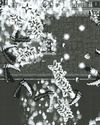
The walls are shifting once more, and our cogs are whirring along with them. More than almost any other Roguelike, Spelunky forces your mind to work overtime as you play. In that regard, its successor is no different. Seemingly every few seconds it demands you make a judgement call, to ask yourself a question and hope that your brain and your fingers can collectively come up with the answer – and quickly, since you can rarely afford to hang about. Can we make that jump? Will the tikiman’s boomerang hit us when we drop? Should we throw that bomb into the spider’s web? Do we risk our last rope to reach that opening to the right? And is that a rideable salamander blowing bubbles down there? We can answer that last one, at least: no, it’s an axolotl, and just wait until you see what else it can do.
Once you’ve spent enough time with Spelunky 2, you’ll instinctively know the answers to those questions – and if you’re unsure of whether you can or should do something, it’s probably a no. If Derek Yu’s sequel raises a few new ones besides, that’s because there’s more of it: more characters, more enemies, more items, more areas. Which in turn means more systems, and more combinations of those systems: many logical, some guessable, others entirely unpredictable. If, as Roger Ebert said, movies are a machine that generates empathy, then Spelunky 2, even more so than the original, is a machine for generating surprise. And, inevitably, its close cousin: delight.
Bu hikaye Edge dergisinin November 2020 sayısından alınmıştır.
Start your 7-day Magzter GOLD free trial to access thousands of curated premium stories, and 9,000+ magazines and newspapers.
Already a subscriber ? Giriş Yap
Bu hikaye Edge dergisinin November 2020 sayısından alınmıştır.
Start your 7-day Magzter GOLD free trial to access thousands of curated premium stories, and 9,000+ magazines and newspapers.
Already a subscriber? Giriş Yap

BONAPARTE: A MECHANIZED REVOLUTION
No sooner have we stepped into the boots of royal guard Bonaparte than we’re faced with a life-altering decision.

TOWERS OF AGHASBA
Watch Towers Of Aghasba in action and it feels vast. Given your activities range from deepwater dives to climbing up cliffs or lumbering beasts, and from nurturing plants or building settlements to pinging arrows at the undead, it’s hard to get a bead on the game’s limits.

THE STONE OF MADNESS
The makers of Blasphemous return to religion and insanity

Vampire Survivors
As Vampire Survivors expanded through early access and then its two first DLCs, it gained arenas, characters and weapons, but the formula remained unchanged.

Devil May Cry
The Resident Evil 4 that never was, and the Soulslike precursor we never saw coming

Dragon Age: The Veilguard
With Dragon Age: The Veilguard, BioWare has made a deeply self-conscious game, visibly inspired by some of the best-loved ideas from Dragon Age and Mass Effect.

SKATE STORY
Hades is a halfpipe

SID MEIER'S CIVILIZATION VII
Firaxis rethinks who makes history, and how it unfolds

FINAL FANTASY VII: REBIRTH
Remaking an iconic game was daunting enough then the developers faced the difficult second entry

THUNDER LOTUS
How Spirit farer's developer tripled in size without tearing itself apart